This is the 55th Thevaram
Paadal Petra Shiva sthalam and 1st Sthalam on the north side of
river Kaveri in Chozha Nadu. This place Thillai was named after a flora called
Thillai Tree ( Excoecaria agallocha Linn ) that dominates in this area.
Chitrambalam ( Chit+Ambalam – small veli or sky ), which turned to the present
name of Chidambaram. Hence this is one of the Pancha Bhutha kshethra / sthalam.
Chidambaram was also called different names line, Puliyur, PerumpaRRappuliyur
during 7th to 8th Century and Pundarikapuram during
purana period. This is the place where the devotees attains mukthi, who
worships Lord Shiva.
In Periya
Puranam, Sekkizhar mentions that, Thirugnanasambandar went to the temple
through south side entrance gopuram / thiruvayil, and he was welcomed by the
Thillai vaazh Andhanars with poornakalasa, Lighting lamps and mangala musical
instruments.
வேதநாதமும் மங்கல முழக்கமும்
விசும்பிடை நிறைந்து ஓங்கச்
சீதவாசநீர் நிறைகுடம் தீபங்கள் திசை
எலாம் நிறைந்து ஆரச்
சோதிமாமணி வாயிலின் புறம் சென்று சோபன
ஆக்கமும் சொல்லிக்
கோது இலாதவர் ஞானசம்பந்தரை
எதிர்கொண்டு கொடுபுக்கார்
செல்வம்மல்கிய தில்லைமூ தூரினில் தென்திசைத் திருவாயில்
எல்லை நீங்கிஉள் புகுந்துஇரு
மருங்கும்நின்றுஎடுக்கும் ஏத்து ஒலிசூழ
மல்லல் ஆவணம் மறுகுஇடைக் கழிந்துபோய்
மறையவர் நிறைவாழ்க்கைத்
தொல்லைமாளிகை நிரைத் திருவீதியைத் தொழுது
அணைந்தனர் தூயோர்
Thirugnanasambandar,
Appar, Sundarar, Vallalar and Idaigal Kadavarkon has sung hymns in praise of
Lord Shiva of this temple.
செல்வநெடு மாடம் சென்று சேணோங்கிச்
செல்வமதி தோயச் செல்வ முயர்கின்ற
செல்வர் வாழ் தில்லைச் சிற்றம் பலமேய
செல்வன் கழலேத்தும் செல்வம் செல்வமே
........ திருஞானசம்பந்தர்
பத்தனாய்ப் பாடமாட்டேன் பரமனே பரமயோகீ
எத்தினாற் பத்தி செய்கேன் என்னை நீ
இகழவேண்டா
முத்தனே முதல்வாதில்லை அம்பலத்தா டுகின்ற
அத்தா உன் ஆடல் காண்பான் அடியனேன்
வந்தவாறே
........ திருநாவுக்கரசு சுவாமிகள்
மடித்தாடும் அடிமைக் கணன்றியே மனனே நீ
வாழு நாளுந்
தடித்தாட்டித் தருமனார் தமர் செக்கி
லிடும் போது தடுத்தாட்
கடுத்தாடு கரதலத்தில் தமருகமும்
எரியகலும் கரிய பாம்பும்
பிடித்தாடிப் புலியூர்ச் சிற்றம் பலத்தெம் பெருமானைப் பெற்றா மன்றே
.......... சுந்தரர்
ஓடுகின்ற நீர்மை ஒழிதலுமே உற்றாரும்
கோடுகின்றார் மூப்புங் குறுகிற்று –
நாடுகின்ற
நல்லச்சிற்
றம்பலமே நண்ணாமுன் நன்னெஞ்சே
தில்லைச்சிற்றம்பலமே சேர்
......... ஐயடிகள் காடவர்கோன்
சொற் பேறு மெய்ஞ்ஞானச் சுயஞ் ஜோதியாந்
தில்லைச்
சிற்சபையில் வாழ்தலைமைத் தெய்வமே –
நற்சிவையாந்
தாயின் உலகனைத்துந் தாங்குந்திருப்புலியூர்க்
கோயிலமர்ந்த குணக் குன்றமே
........ வள்ளலார் திரு அருட்பா
Moolavar : Sri Thillai Natarajar, Sri Ambalakoothhar,
Sri
Chirtrambalmudayavar, Sri Ambalavaanar.
Consort : Sri Sivakami, Sri Sivakamsundari
Some of the important features of
this temple are....
Chitrambalam : Roof was covered with Gold. Moolavar – Natarajar not
the usual Shiva Linga with avudai and banam. Moolavar Natarajar is of metal
icon in dancing posture, facing South.
Natarajar belongs to 10th Century Chozha period. Spadika Linga is
kept under the feet of Natarajar in a golden box. Daily Abhishekam is to this
Spadika Linga and Linga is taken to Palliyarai after artha jama pooja. There
are 5 steps panchachara steps made of stone built to climb up to the sanctum.
There are two stone elephants on both sides. It is believed that when one of the 14 shasthras placed on the step, one
of the elephant took and placed under Lord Nataraja’s feet. Hence that book is
called as Thirukalitrupadiar. Right side of moolavar “Chidambara rakasyam” is
in the form of golden vilva leaves maala/garland, hanging on the wall - which
signifies the Lord Shiva and Parvati are there without roopam or aroopam). As
per Appar, this Chitrambalam roof top was paved with pure Chempon. This
Chitrambalam is also called as “Thapra Sabha”.
Thiruvalangadu copper plate and the Leiton copper plate records that golden
plate was paved by Aditha Chozha’s son Parantaka-I. The Sthala purana mentions
that roof was paved with Golden plates by Hiranyavarman.
Ponnambalam ( Kanaka Sabha ): This is the place where Lord Shiva’s
sacred bath is done, front portion of the Chitrambalam. The 6 kala abhishekam
with pooja are conducted for the Spadika Linga and 2nd kala
abhishekam will be done for Rathana Sabapathy. As per Sekkizhar, in Idangazhi
Nayanar’s purana he records that the roof was paved with gold, which was
brought from Kongu mandalam by Aditha
Chozha-I. One of the inscription in the form of poem, records the gold plate
paving was done by ardent Devotee and a Chieftain Manavil Koothan alias
Kalingarayan.


Perambalam: Also called as Deva Sabha. This sabha’s roof was paved with copper plates
by Vikarama Chozha’s Chieftain Manavil Koothan alias Kalingarayan, which is
inscribed in the form of poem. The Inscriptions further records that Manavil
Koothan gifted Chemporkaalam, built 100 pillar mandapam, Nandhavanam, Mandapa
for reciting Thevara Thirupathikams / hymns, Thirumurai Cheppedu, and 1000 cows to this temple. Latter this was
replaced with gold plates by Kulothunga-III.
Nirutha Sabai: This sabha is on the South side of dwajasthamba. Lord
Shiva danced in this place and the dance is called as Oorthuva thandavam.
An idol is in this sabha.
Raja sabai: This is also called as 1000 pillar mandapam ( Details are
written below ). Abhishekam will be done at Chitrambalam panchatchara steps and
Coronation Ceremony of Chozha kings used to be conducted in this
mandapam. The Coronation to the kings was done by the Andhanar’s of
Thillai.
15th Century
Arunagirinathar has sung hymns in praise of Lord Muruga
of this temple
இருவினையின் மதி மயங்கித் திரியாதே
எழுநரகிலுழலு நெஞ்சுற் றலையாதே’
பரமகுரு அருள் நினைந்திட் டுணர்வாலே
பரவு தரிசனையை யென்றெற் கருள்வாயே
தெரி தமிழை யுதவு சங்கப் புலவோனே
சிவனருளு முருக செம் பொற் கழலோனே
கருணை நெறி புரியுமன்பர்க் கெளியோனே
கனக சபை மருவு கந்தப் பெருமாளே
HISTORY AND ARCHITECTURE.
The
prakaram wall bearing the Vikrama Chozha inscriptions was constructed during 12th century
with an entrance opposite to stucco Rishabam and balipeedam. The South entrance,
was existed till 19th century. It was told there was a Nandanar
statue at the south side entrance. The entrance was closed
during, 20th century beginning and the fate of
Nandanar’s statue is not known.
RAJAGOPURAMS.
There
are 4 Rajagopurams ( all the Rajagopurams are built with same height even
though they were built during different periods and by different Dynasties ) of
7 tiers, 135 feet tall. The entrance is of 40 feet high and 16 feet wide with
single stone lintels. The Rajagopuram is constructed with stone up to lintel
and the super structure is of stucco. The passage walls has the reliefs of 108
Bharatanatyam postures. Stucco images of deities are on the Gopuram. All
the 4 saints are believed to be entered through 4 Rajagopurams, though it may
not be existed during their periods.
The
east Rajagopuram was constructed by Vikrama Chozha through which Manickavasagar
entered in to the temple. The base has two tiers in which various sculptures
and deities like Pichadanar, Gajasamhara murti, Gangadhara, Gangalar, Mahishasuramardini
are there. The Tri colour National flag will be hoisted on this top of the
gopuram on August 15th of every year, by Deekshithars.
Manickavasagar being welcomed by Deekshithars
The
south Rajagopuram facing Nataraja is called as Chokka Seeya Gopuram, the title
of Koperunchingen, who built it and Thirugnanasambandar entered through this
Rajagopuram.
The
west Rajagopuram was built by Jadavarman Sundara Pandyan and the entrance to the
sanctum complex is opposite to it and also called as Akalangan Vayil.
Appar entered through this Rajagopuram.
The
16th century North Rajagopuram was built by Krishna Devaraya of
Vijayanagara Dynasty. Krishna Devaraya and his sthapathi’s images are in the
North side of the Rajagopuram passage. Sundarar entered through the
Rajagopuram ie from back side of Natarajar.
SABHA MANDAPAMS.
Vikrama Chozha's chieftain Naraloka
Veeran had constructed the 100 pillared Mandapam and Ambal temple mandapam. It
was also told that most of the present structures are built by Naraloka Veeran.
In the 100 pillared mandapam 12 pillars forms a mandapam called Chozhan
Thirumandam. It is also believed that some of the mandapams around sanctum are
built by Hiranyavarman of Koudilya Kingdom.
The 1000 pillared ( 984 pillars ) mandapam was constructed by Koluthunga –II
and III and the portico was constructed during Vijayanagara period. In the Raja
shabai, Aani thirumanjanam and Arudra functions are held. Manickavasagar
defeated Buddhist monks in an argument in this mandapa. Periya puranam written
by Sekkizhar was also inaugurated in this mandapam.
Nirutha
Sabha ( Ethirambalam ). As per the legend, Dance competition was held
between Thillai Kali and Lord Shiva in which Thillai Kali could not
perform Dance like Lord Shiva. The mandapam was built like a chariot pulled by
galloping horses with 56 intricately carved pillars.
Nirutha mandapa Pillars
Nirutha mandapa Pillars
Deva Sabha is facing south with 100
bronzes idols (?). Kulothunga-II, covered this roof with gold, Kanaka Sabha and
Chit Sabha otherwise called as Ponnambalam. As per the legend the Viswakarma
built this Sabha on the request of Indran for Shiva’s Ananda thandavam. This
was believed to be constructed by Aditya-I. It is also believed that, this
Sabha was constructed with 64 wooden beams ( represents 64 arts ), 2600 lotus
petals ( this represents the breathing count of a human ), 72,000 nails ( human
body’s nerves, veins and heart beats ) and 9 kalasas.
SHRINES /SANNADHIS.
Mukkuruni Vinayagar is sculptured out
of a monolithic/single stone belongs to 17th century. Heramba
Ganapati bas relief is on the second pillar from the entrance of the mandapa.
Thirumoola
Vinayagar sannidhi is on the right side of the West side Rajagopuram. The mukha
mandapa is supported with a single pillar. It is believed that, it signifies
the Kundalini shakti.
Sivakamasundari
Temple was constructed during Kulothunga period. Chithra gupta Shrine.
Dwajasthambam mandapa, which has beautiful paintings on the ceiling. Meenakshi
Sundareswarar temple built by Pandyas after defeating Chozhas, in remembrance of
Madurai. Pandi Nayakam temple was built by the Pandyas with 56
intricately carved pillars.
Next to north side Rajagopuram is
the Nine Shiva Linga Temple. The Shiva Lingas are of Dhara Linga with 8 flat
surfaces. The nine Shiva Linga’s flat surfaces are added which works out to 72,
which signifies the addition of Nayanmars and Thokai adiyars. As per the
inscriptions this temple is called as "Thiruthonda thokaieechuram".
The Urdhva Thandava murthy is on
the western side of the Nirutha Sabha mandapam. Shiva is in dance postures with
lifting his leg up pointing the sky.
Moolattanavar sannadhi is in the
second prakaram. It was believed that this shrine with Shiva Linga exists
before installation of Nataraja. This moolanathar was worshiped by Patanjali,
Vyaghrapada, Upamanyu and King of Kautilya kingdom, Vanga country ( Present
Bengal, part of Odisha and part of Bihar ). It was believed that the temple
belongs to early Chozha’s period.
Govindaraja Perumal temple also known as Thiruchitra koodam. This Maha
Vishnu was installed by the Pallava King
Nandhi Varman during 726 to 775 CE. Mangala sasanam was done by Thirumangai Alwar and Kulasekara Alwar. Perumal
was removed during Kulothunga Chozha-II and thrown in to bay of Bengal ( Hence he
was called as Kirumi kanda Chozhan ) and re installed back during Vijayanagara
Period.
Govinda Raja Perumal sannadhi
Thayar Sannidhi
In Natarajar sanctum, Sivakama Sundari,
Chandra Mouleeswarar, a spatika Lingam, Rathna Sabhapathy, Swarna Akasa Bhairava,
Chandrasekarar. Natarajar belongs to 10th century Chozha period.
HISTORY AND INSCRIPTIONS
As per the early Chozha period inscriptions this place was called as Perumpatrapuliyur and Chidambaram was mentioned in the latter period inscriptions. Lord Shiva is called as Thiru Chitrambalamudayar and Ambal is called as Thiru Kamakottathu Periya Nachiyar.
About 500 inscriptions are recorded from this temple belongs to 850 to 1300 CE, out of them more than 50% belongs to Pandyas, Vijayanagaras, etc,. The Chozha period inscriptions refers nearly 34 other temples, 12 mutts and 3 institutions close to Chidambaram. Nearly 70 numbers of Chozha period inscriptions records the establishment of Nandhavanam / flowering gardens, appointing gardeners, and offering flowers for garlands. It was mentioned that at one time 2750 garlands per day are offered to the temple.
Several inscriptions records the establishment and maintenance of complicated but organised network of irrigation channels to the settlements in and around Chidambaram.
The Prantaka-I period inscription believed to be earliest records the renovation, extension of Chit Sabha and celebration of festivals.
The Chozha King Kulothunga Chozha’s inscription speaks about the special and rare stone gifted by the king of Kambhoja placed in the Chitrambalam. The inscriptions reads as...
”இந்த கல்லு திருவம்பலத்து திருக்கல் சரட்டில் திருமுன்பட்டுக்கு மேலே பட்டியில் வைத்தது”.
Naralokaveera, the Commander in chief of Kulothunga-I and Vikrama Chozha has several long running inscriptions in Tamil and Sanskrit records his contributions to the temple. The list includes Sandhi Vilakku / veethi deepa/ street lamp, a mandapa near the sea for Nataraja’s Theertha yathra, broadening the processional streets, gilding several structures, footpaths around the temple, gold, precious stones, jewels, gold vessels, Vahanas, tanks, Compound walls, etc,. He also has got around 8000 Thevara hymns, engraved on a copper plates and kept them in reverence in the temple. He also installed the image of Thirugnanasambandar and made endowments to recite his hymns during festival times.
Vikrama Chozha period inscription records the a Chariot, canopied with pearls to be drawn around the streets in the Tamil month of Puratasi ( Sept- Oct ).
An inscription records the existence of manuscript Library called Saraswati Bhandaram in the temple. Several important texts including Sidanta Ratnakara was available in the Library. It has existed more than 500 years and is last mentioned in the Jatavarman Sundara Pandyan’s period inscriptions. Latter might have been brought down and burnt during Islamic invasion.
The Sundarapandya's inscription in the form of a poem, records the victory over Chozhas. In that Sundara Pandya was called as "Senthamizh Thennavan - செந்தமிழ் தென்னவன்". The second inscription records the Victory over the Pallava King Kadavarkon Koperunsingan. In that he was praised as "Sundara Meenavan - சுந்தர மீனவன்". Both poems are as follows.... "ஸ்வஸ்திஸ்ரீ :-
காரேற்ற தண்டலைக் காவிரி நாடனைக் கானுலவுந்
தேரேற்றி விட்ட செழுந்தமிழ்த் தென்னவன் சென்றெதிர்ந்து
தாரேற்ற வெம்படை யாரியர் தண்டுப்படத் தனியே
போரேற்று நின்ற பெருவார்த்தை யின்றும் புதுவார்த்தையே
பண்பட்ட மென்மொழிப் பைந்தொடி கொங்கையர்க் கவைமேற்
கண்பட்ட முத்தவடங் கண்டு காக்கிலன் காடவர்கோன்
எண்பட்ட சேனை யெதிர்பட் டொழுக வெழுந்து புண்ணீர்
விண்பட் டலையப் படைதொட்ட சுந்தர மீனவனே.
Both Chozhas and Pandyas crowning ceremony was conducted in this temple. Also Thulapara worship was started by the Pandya King Jadavarman Sundara Pandyan and golden covering was done by him. The details of the Tamil Poem inscription is given below. சிதம்பரத்தில் உள்ள கல்வெட்டு மிக்க அழகியலோடு சுந்தர பாண்டியன் (ஜடாவர்மன் - I) தங்க துலாபாரம் ஏறியதை வர்ணிக்கிறது.
த்வாமேத்ய பூபதிரவே வினதா: ப்ரகாமம்
உச்சை: பதம் நியதமத்புதமாஶ்ரயேரன்|
பாரானதோ யததுனா பவதஸ்துலாயாம்
ஶம்போர்விமானமதிரோஹதி ஹேமராஶி:||
அரசர்களில் கதிரவனே, உன்னை அடைந்து வணங்கியவர்கள் உண்மையாக அற்புதமான உயர்ந்த பதவியைப் பெறுவார்கள். இப்போதும் பார்த்தால் தன் எடையால் உன்னை வணங்கித் தராசில் தாழ்ந்து நிற்கும் பொற்குவியல் சிவபெருமானின் விமானத்தின் மீதே வீற்றிருக்கும் பேறு பெற்றுவிட்டதே. From this inscription it is clear that the Gold plating of Ponnambalam was done by the Pandya King Sundara Pandyan.
The latter Pallava King Koperunchinga frequently referred ( AR 455 to 168 of 1902, SII, VIII- 43 to 56 ) in many inscriptions. His Coronation was done here, built the west Rajagopuram and donated extensively to this temple.
Natarajar was taken to Malainadu and Thiruvarur during Malik Kafur’s invasion
1311 and 1325 CE. Believed that Natarajar returned to his original position
during 14th century, during Vijayanagara Period.
Krishna Devarayar had donated 82 villages to this temple for conducting regular poojas and functions.
The Temple faced a massive destruction during Malik Kafur’s invasions of South India between 1311 and 1325 CE.
In 1753 CE, the temple was occupied
by the French and a garrison was set up in side the temple premises. In 1759 CE
the temple was attacked by British and latter occupied by the French.
1780 CE Hyder Ali occupied the
temple and British occupied after defeating Hyder Ali in 1781CE. During this
period Natarajar was taken to Thiruvarur.
Pachaiappa Mudaliyar had contributed towards renovation of Temple
Chariot, base. After his demise, his wife and his sister had completed the
task.
Manali Chinnayya Mudali also contributed towards Nandavanam, covering Chit
Sabha with silver, etc.
Nattukottai Nagarathar’s also extending their share towards maintenance of the
temple, sannadhis, Rajagopurams, rectification of Sivaganga tank steps. Laying
of pathways using stone slabs, rectification of Kanaka Sabhas roof
etc,.
Some claims that, during Rajarajan period thirumurai were brought to light from a closed room of the prakaram through Nambiyandar Nambi ( The prakaram Vinayagar showed the way ). But as per the experts, Since Nambiyandar Nambi doesn’t belongs to Rajaraja period and Rajarajan was not responsible to bring out the Thirumurai.
Ref
1. South Indian Inscriptions Volume - VIII
2. South Indian Inscriptions Volume - III, Part-II
3. South Indian Inscriptions Volume - IV
4. South Indian Inscriptions Volume - XII
5. A book on "South Indian Shrines", written by Jagadisa Ayyar, published by "Asian Educational Services"- 1993.
6. Thenninthiya Koil Sasanangal, Volume-I.
7. Annual Report on South Indian Epigraphy Year 1888, 1892, 1902, 1913 and 1918.
8. Thanjavur District Inscriptions.
9. Avanam 11.
Chozha period inscriptions on the wallInscription stone placed on the floor during renovations
DHIKSHITHARS AND THEIR ROLE.
As per Thevaram there were 3000 Deekshithars,
who does service to Lord Shiva. The 3000 had shrunk to 200 to 300 now. Chozhas
had given the total control of the temple to the Deekshithars and it has
become a private temple. The Nayanmars ThiruGnanasambandar and Sundaramurthy
praised the Deekshithars in thevara hymns. They had the privilege of crowning
the Chozha kings and Latter to Pandyas. The temple activities are being managed
by a 9 member committee. The Key of the temple including Lords jewellery are
kept in custody of Deekshithars for every 20 days on rotation. It
was told that the pooja can be performed only by a married person and child
marriages are quite common among these deekshithars ( Hope not happens nowadays.....).
LEGENDS
As per the legend, 3000 Deekshithars
went for Brahma’s Yaga conducted at Andharvedi a place on the banks of river
Godavari. After completion of the Yaga, Brahma asked them to take food. The
Deekshithars politely denied and said
that they can take food only after Nataraja’s darshan. Brahma knew that
his Yaga will not be fulfilled if Deekshithars do not take food. So he started
meditate on Lord Shiva. Lord Shiva appeared in the form of Rathnasabapathy and
gave darshan to Deekshithars. After return when they counted it was only 2999.
They confused, who was missing and counted again and found the same one short
of 3000. When they were puzzled, they heard the divine Voice of Lord Shiva from
Chitrambalam, saying that he was one among them, who accompanied with them to
the Yaga and asked them to count him ie Lord Shiva as one. Hence the
Deekshithars treat Lord Shiva as one among them in all respects.
Lord
Shiva’s Dance in this temple is called
as Ananda Thandavam. At the end of Pichadanar form to teach lesson of Whos is
great, for Tharuka vana Rishis, Lord Shiva Danced the Ananda Thandavam which
was witnessed by Maha Vishnu, Brahma and other Devas. Patanjali and
Vyaghrapada also wants to see Lord Shiva’s Ananda Thandavam. As advised both
installed Shiva Lingas at Thillai and worshiped Lord Shiva ( Vyagrapureeswarar
/ Ilamaiyakkinar and Anandheeswarar Temple ). For both of them Lord Shiva
danced this ananda thandavam at this place.
This legend is related to The Kouda
deasa ( Present Bengal, part of Odisha and Bihar ) King Hiranyavaraman. The
Koudadesa Kings son Swethavarman was suffering a from a skin decease. Even-though
he has to crown as next king, he gave it his brother and started his
pilgrimage. He took bath in many holy rivers and tanks before reaching
Chidambaram. A hunter guided him to this Thillai Natarajar temple. He came to
Natarajar Temple and he was guided by the Deekshithars and took bath in the
Holy Sivagangai tank. To his surprise he came out like golden colour complexion
and relieved from the decease. The Deekshithars, Pathanjali and Vyagrapatha
requested him to rule this place. So he sent people to Kouda Desam and brought
his crown and coronation was done by the Deekshithars at this temple as a King
of this place.
Nandanar also called as Thirunalai
Povar, one of the 63 Nayanmars, after
three days circumambulation of Thillai / Chidambaram, he was very
much disappointed of not having darshan of Lord Nataraja. On the
third day night he stayed in a coconut palm farm, on the outskirts of
Chidambaram. Gopalakrishna Bharathi, in his sings express the feelings of Nandhanar than
Sekkizhar. Written like “irakkam varaamal ponathen ? – இரக்கம் வராமல் போனதேன் ?”… Lord Shiva decided not to
make Nandhanar to wait any more. In that night Lord Shiva came in his dream and
asked him to come to the temple for the darshan. Dhikshithars will welcome you
and they will create a fire, immerse and come out like Yogi, leaving the
pulayar caste sentiments. Lord Shiva also told the same in all 3000 Dikshitar’s
dream.
Next
morning all the Dikshitars were waiting with poorna Kumba to welcome Nandanar
at the south side entrance of Natarajar temple. Nandanar came to the south side
entrance and hesitate to enter in to the temple. Dikshitars told him that Lord
Shiva had asked to welcome him in all Dikshitar’s dream. Nandanar
immersed in the fire and came out as Nandha Mamuni with Jadabaram over his
head, wearing rudraksha and yakno pavithira. Nandanar went inside the temple along
with Dhikshithars and had the darshan of Lord Nataraja. Nandanar went near
Nataraja and disappeared. As per Sekkizhar.. ..
உலகு உய்ய நடம் ஆடும்
எல்லையினைத் தலைப்பட்டார்
யாவர்களும் கண்டிலரால்.
Some of the Miracles happened in
this temple are :
Manickavasagar defeated
Buddha and make the dumb girl to speak. Thirugnanasambandar treated all
Thillai andhanars as Sivagnanis. Umapathy Siva sung the Kodikavai to hoist the
kodi ( Flag ). Senthanar has sung the song to make the Chariot to move / run.
In this temple only Thirumaraikal came to this world after it was locked in a
room after many years. Lord Shiva asked Sekkizhar to write the
Siruthondar puranam with the first step given by lord.
The
phrase “Chidambara Ragasiyam” is not the literal meaning of that place covered
with curtain where the Vila leaves ( Aegle Marmelos) malas are hung. The actual meaning is
different. It is believed that Lord
Shiva and Parvati are in aroopa form. The significance of removing of curtain –
ie removing the person’s maya between him and Lord Shiva. To realize or to see
himself, the person has to apply his soul and mind.
POOJAS & CELEBRATIONS
Apart from regular poojas, special
poojas are conducted 6 annual maha abhishekam ( Chithirai onam, Aani
Thirumanjanam, Aavani Chaturdashi, Puratasi Chaturdashi, Arudra abhishekam and
Masi Chaturdashi ), Nayanmar Utsavam, Sri Sivakamasundari Utsavam, Amman
Rathotsavam, Pooarachalankai Pattu Vaangal, Maalai Maatral Kannoonjal-
Thirukalyanam, Soorasamharam, Devasena Subramaniar Kalyanam, Srimoolanathar
annabhishekam, Thai Poosam Pancha moorthy veedhi purappadu, Theerthavari in
Sivagangai, Thandava Darshana aarathi and maha Shivaratri. Anna pavadai and Dasa Theertha festival, in which Natarajar is
taken to 10 different Tanks around the temple/ city are also conducted.
TEMPLE TIMINGS
The temple will be kept opened
between 06.00 hrs to 12.00 hrs 17.00 hrs to 22.00 Hrs
CONTACT DETAILS:
C.G.
Nirtha Sundhara Deekshithar 9443635280 /9791494280
HOW TO REACH:
Buses are available from all
district head quarters of Tamil Nadu.
The temple is 1.8 KM from railway
Station 1 KM from Bus terminus.
The Temple / Chidambaram is 19 KM
from Sirkazhi, 39 KM from Mayiladuthurai, 54 KM from Virudhachalam, 56 KM from
Cuddalore, 75 KM from Villupuram and 230 KM from Chennai.
Nearest
Railway station is Chidambaram
East Rajagopuram
The white patch on the wall- on the other side is the Niruthamandapa-- wall opened to move materials during renovations.
Mukkurini Vinayagar sannidhi
Mukkurini Vinayagar Heramba Ganapathy - in Mukkurini Vinayagar Sannidhi
Ambal Sannadhi
SIvagangai Theertham with Ambal and North RajagopuramKalyana Sundareswarar Sannidhi
Before renovation
After renovation
Rishabha mandapam
Dakshinamurthy Sannidhi
"Thiruthonda thokaieechuram".
"Thiruthonda thokaieechuram".
Vikrama Chozha ?
Murugan and Gajasamkaramurthy
Pichadanar and Gangalar
Musician and Dancer Krishna Devararaya & Vijayanagara Sculptors on both sides Vijayanagara Sculptors
Nandhiyam Peruman with his consort --Thiripuranthagar
Brahma Mahishasuramardini

Mahavishnu on Garuda and Bairava
Arumugar
Vinayagar sannadhi ( Single Pillar mandapa)
KazhuvetramCorridor
Nalvar Sannadhi- Believed that the Thirumurai was kept here
Temple Layout - PC Web site ---
OM SHIVAYA NAMA ---









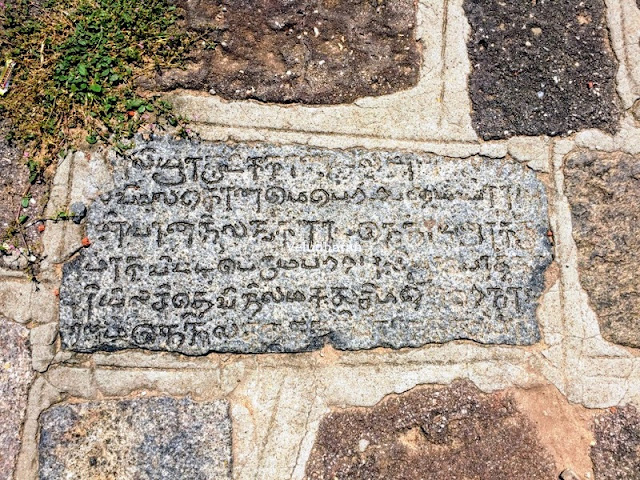









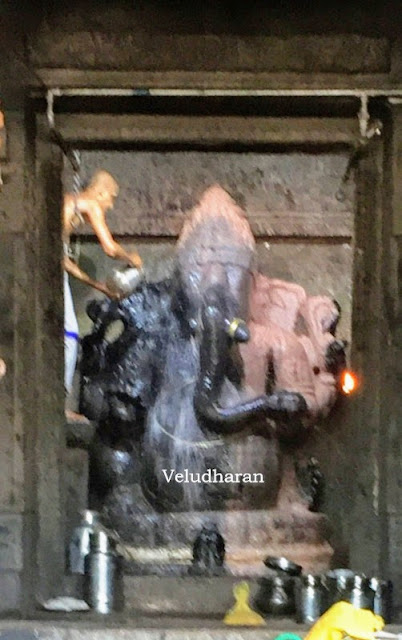










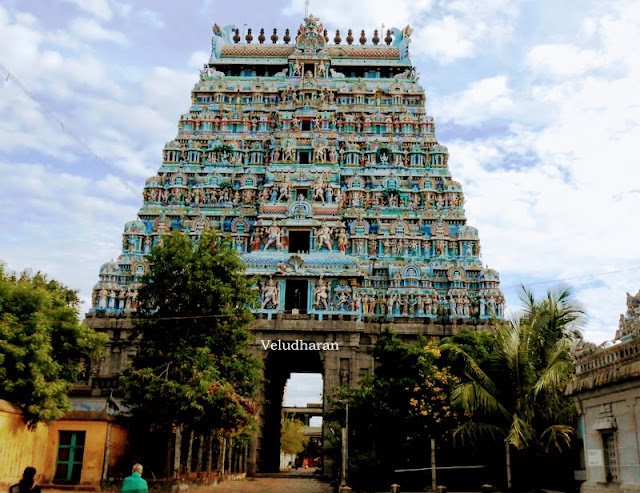



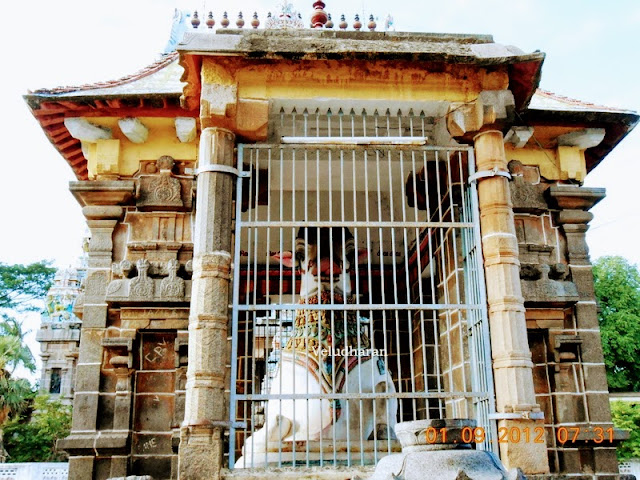
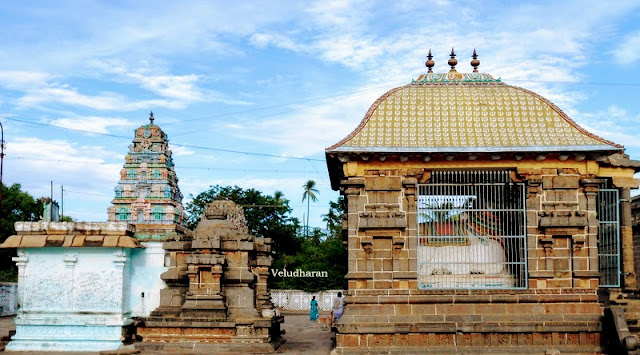







































No comments:
Post a Comment